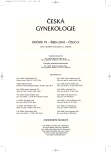Vacuumextraction
Authors:
O. Šimetka; I. Michalec
Authors‘ workplace:
Porodnicko-gynekologická klinika, FN Ostrava, přednosta MUDr. O. Šimetka
Published in:
Ceska Gynekol 2010; 75(5): 417-422
Overview
Objective:
To summarize available data concerning vacuumextraction and it’s use in the Czech Republic.
Design:
Review article.
Methods:
Compilation of published data from scientific literature.
Conclusion:
The rate of vacuumextraction use in the Czech Republic is one of the lowest in the world. Forceps is usually the preferred technique. The use of vacuumextraction is on the rise, the limiting factor is the fact that in Czech Republic it is not recommended in cases with presumed fetal distress. According to world literature, the preferred technique in cases where operative vaginal delivery is indicated should be vacuumextraction due to significantly lower risk of maternal trauma. An obstetrician should be familiar with both techniques – vacuumextraction and forceps. It up to him/her which instrument is used based on his/her own competency, experience and circumstances of the labour.
Key words:
vacuumextraction, forceps, trend, Czech Republic.
Sources
1. Johanson, RB., Menon, V. Vacuum extraction versus forpces for assited vaginal delivery (review), Cochrane Database of Systematic Reviews 1999, Issue 2. Art. No. CD 000224. DOI: 10.1002/14651858.CD000224.
2. Johanson, RB., Menon, V. Soft versus rigid vacuum extractor cups for assisted vaginal delivery. Cochrane Database of Systematic Reviews 2000, Issue 2. Art. No. CD 000446. DOI: 10.1002/14651858.CD000446.
3. Johnson, J., Figueroa, R., Garry, D., et al. Immediate maternal and neonatal effects of forceps and vacuum-assisted deliveries. Obstet Gynecol, 2004, 103(3), p. 513-518.
4. Murphy, DJ., Macleod, M., Bahl, R., et al. A randomised controlled trial of routine versus restrictive use of episiotomy at operative vaginal delivery: a multicentre pilot study. BJOG, 2008, 115(13), p. 1695-1702; discussion 1702-1703.
5. Suwannachat, B., Lumbiganon, P., Laopaiboon, M. Rapid versus stepwise negative pressure aplication for vacuum extraction assited vaginal delivery. Cochrane Database of Systematic Reviews 2007, Issue 3. Art. No. CD006636. DOI: 10.1002/14651858. CD006636.
6. Vintzileos, AM., Nochimson, DJ., Antsaklis, A., et al. Effect of vacuum extraction on umbilical cord blood acid-base measurements. J Maternal Fetal Med, 1996, 5, p. 11-17.
7. Miksovsky, P., Watson, W. Obstetric vacuum extraction: State of the art in the new millenium. Obstet Gynecol Survey, 2001, 56(11), p. 736-751.
8. Ott, WJ. Vacuum extraction. Obstet Gynecol Surv, 1975, 30, p. 643-649.
9. Samuelsson, E., Ladfors, L., Wennerholm, UB., et al. Anal sphincter tears: prospective study of obstetric risk factors. Br J Obstet Gynaecol, 2000, 107, p. 926–931.
10. Poen, AC., Felt-Bersma, RJF., Dekker, GA., et al. Third degree obstetric perineal tears: Risk factors and the preventive role of mediolateral episiotomy. Br J Obstet Gynaecol, 1997, 104, p. 563–566.
11. Combs, CA., Robertson, PA., Laros, RK. Risk factors for third-degree and fourth-degree perineal lacerations in forceps and vacuum deliveries. Am J Obstet Gynecol, 1990, 163, p. 100–104.
12. Angioli, R., Gomez-Marin, O., Cantuaria, G., et al. Severe perineal lacerations during vaginal delivery: The University of Miami experience. Am J Obstet Gynecol, 2000, 182, p. 1083–1085.
13. de Leeuw, JW., Struijk, PC., Vierhout, ME., et al. Risk factors for third degree perineal ruptures during delivery. Br J Obstet Gynaecol, 2001, 108, p. 383–387.
14. MacArthur, C., Bick, DE., Keighley, MRB. Faecal incontinence after childbirth. Br J Obstet Gynaecol, 1997, 407, p. 46–50.
Labels
Paediatric gynaecology Gynaecology and obstetrics Reproduction medicineArticle was published in
Czech Gynaecology

2010 Issue 5
Most read in this issue
- Laboratory and clinical indicators of the state of the newborn after birth
- Vacuumextraction
- Lesions of peripheral nerves in obstetrics and gynecology. A review
- The efficiency of oral contraception containing drospirenone in treating symptoms of premenstrual syndrome or premenstrual dysphoric disorder in gyneacology practice
